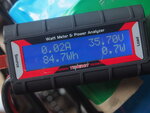You can get any digital voltmeter to check your ebike battery voltage and also to use around the house, if that's OK for you. Mine range from the Centech units that are often on sale for under $4 at Harbor Freight to better quality models such as a $20 Craftsman from Sears.
It is somewhat difficult to assess an ebike battery via a voltmeter. For example, a 48V battery made with 18650 Li-Ion cells will come in at 54.6V when fully charged. If it shows 48V, it's about half capacity. Your controller probably shuts the bike off when the battery goes under 42V. At that point, there might be 10-15% charge still left.
I prefer to use a wattmeter like the Ternegy in the picture. They only cost $12-13 on ebay, and will give you the voltage (usually off by 1/2 volt, but it's consistent). It connects between battery and controller, or between battery and charger.
They also show the total watthours used, but I found that also inaccurate. The info that seems to be good is the amperes being drawn as well as the amp-hours (AH). This is the same AH as advertised on your battery.
View attachment 22250



